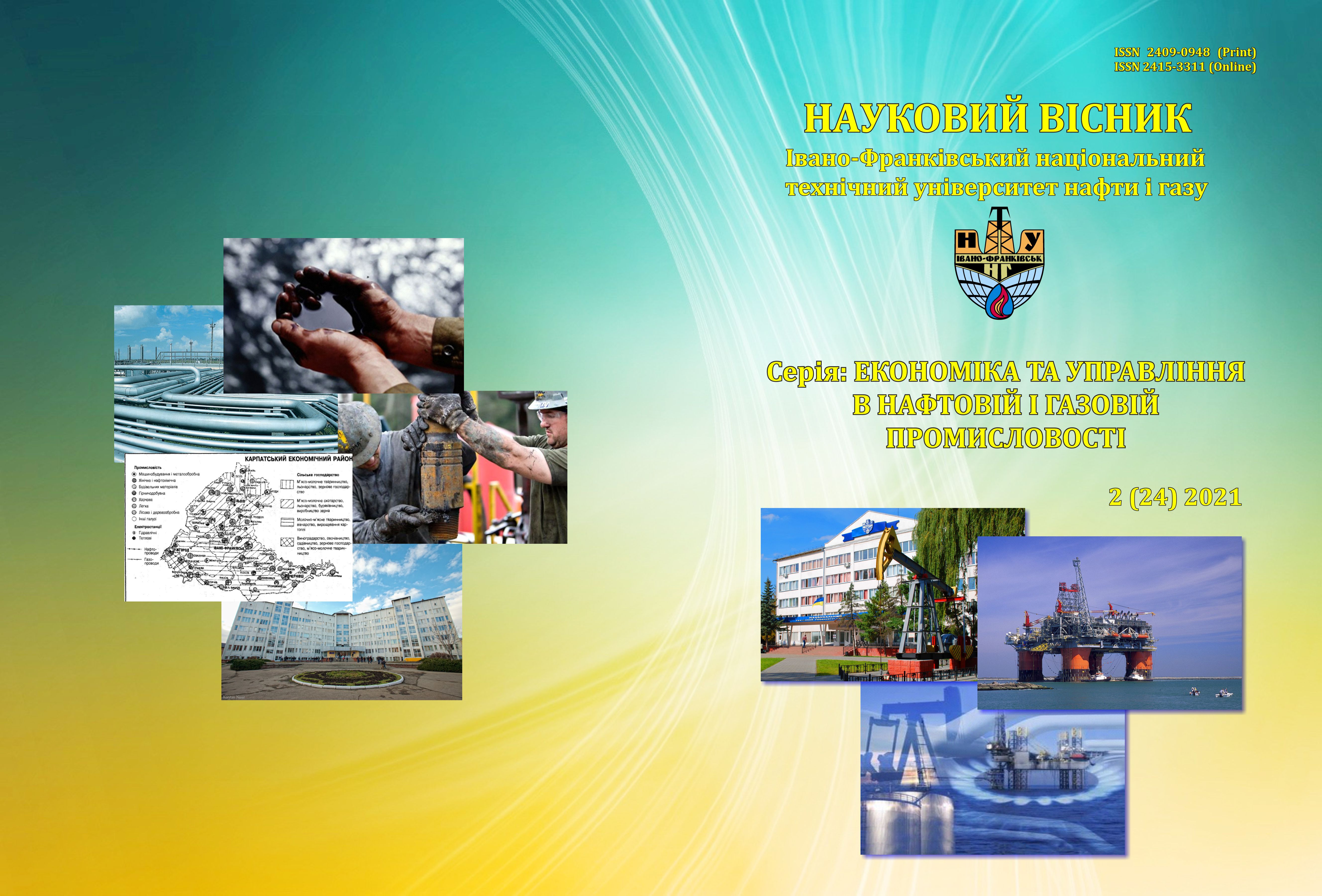GAS EXTRACTION IN UKRAINE: CURRENT POSITION, PROBLEMS AND FUTURE DIRECTIONS IN THE ENERGY MARKET
DOI:
https://doi.org/10.31471/2409-0948-2021-2(24)-7-16Keywords:
gas, extraction, market, state, problems, prospects, NJSC "Naftogaz of Ukraine"Abstract
Abstract. The article is devoted to the current position and problems of gas extraction in Ukraine, and outlines the future leading directions in the gas market.
It has been found that in recent years Ukraine has produced 20 billion cubic meters of natural gas, which is significantly less than its production in 1975 (68 billion cubic meters). Today the largest share of natural gas production in Ukraine is carried out by JSC "UkrGasVydobuvannya” (about 70%), PJSC "Ukrnafta" (about 6%) and private enterprises (24%). Moreover, the main reasons for the reduction of gas extraction in Ukraine have been studied. Such reasons include: depletion of easily extracted gas reservoirs during the Soviet Union; lack of exploration, drilling, development of new deposits through the transfer of technical, technological and human resources for the development of deposits in western Siberia. In addition, during Ukraine's independence, along with political pressure from Russia's gas supply, no mechanisms have been launched to increase gas extraction in Ukraine.
Taking into account modern realities, global challenges and threats to energy security, instability of prices on the world market, the need to increase the capacity of domestic gas extraction is substantiated. While considering the existing natural gas deposits in Ukraine, it could be argued that increasing our own production is quite achievable.
The paper also highlights the prospects for the development of gas production in Ukraine (including the involvement of foreign companies with their latest technologies for exploration of the reservoir) and gas market development in the context of the strategy "From the drilling company to the national energy services operator." Implementation of the action plan of Naftogaz of Ukraine to focus on customer needs; intensive exploration and development of new gas extraction sites; actively promoting the development of energy markets; involvement of professionals and partners; acquisition of new knowledge and technologies; entering new businesses and increasing operational efficiency will improve the situation on the gas market.
References
References
Diiak I.V., Osinchuk Z.P. (2000). Hazova promyslovist Ukrainy na zlami stolit. Ivano-Frankivsk: Lileia-NV. 236 s.
Osinchuk Z. P. (2008). Osnovni vikhy rozvytku hazovoi promyslovosti Ukrainy. Naftova i hazova promyslovist. № 1. S. 3-6.
Vytvytskyi Ya.S. (2007). Ekonomichna otsinka hirnychoho kapitalu naftohazovykh kompanii: naukova monohrafiia. Ivano-Frankivsk: IFNTUNH. 431 s.
Atamanchuk D. I. (2012). Suchasni instrumenty otsiniuvannia investytsiinykh proektiv u hazovii promyslovosti. Visnyk Khmelnytskoho natsionalnoho universytetu. Ekonomichni nauky. № 2, T. 1. S. 123-127. http://journals.khnu.km.ua/vestnik/pdf/ekon/2012_2_1/123-127.pdf
Kinash I. P., Stankovska I. M. (2020). Osoblyvosti rozvytku korporatyvnoi kultury naftohazovykh pidpryiemstv. Visnyk Khmelnytskoho natsionalnoho universytetu. Ekonomichni nauky. No 6. S. 120-124. URL: http://journals.khnu.km.ua/vestnik/wp-content/uploads/
/03/20.pdf
Muzychenko M. V. (2017). Suchasnyi rynok pryrodnoho hazu YeS: struktura ta tendentsii rozvytku. Investytsii: praktyka ta dosvid. № 22. S. 46-52. URL: http://www.investplan.com.ua/?op=1&z=5796&i=9
Dzoba O. H., Kinash I. P. (2019). Vplyv hlobalnykh chynnykiv na rozvytok hazovoho rynku. Naukovyi visnyk Ivano-Frankivskoho natsionalnoho tekhnichnoho universytetu nafty i hazu. Seriia: Ekonomika ta upravlinnia v naftovii i hazovii promyslovosti. № 2. S. 33-44. URL: http://elar.nung.edu.ua/handle/123456789/7462
Dykha M. V. (2014). Fiskalni innovatsiini dzherela vyrishennia problem sotsialno-ekonomichnoho rozvytku Ukrainy. Visnyk Khmelnytskoho natsionalnoho universytetu. Ekonomichni nauky. № 2, T. 2. S. 81-88. URL: http://elar.khnu.km.ua/jspui/handle/
/2464
Dykha M. V., Dykha V. V. (2021). Enerhetychna bezpeka Ukrainy u konteksti zahroz zapusku «Pivnichnyi potik – 2» Instrumenty rehuliuvannia natsionalnoi ekonomiky ta natsionalnoi bezpeky v umovakh suchasnykh hlobalnykh vyklykiv: zb. nauk. prats za mater. VI Mizhnar. nauk.-prakt. konf. (5 lystopada 2021 r.). Khmelnytskyi: KhNU. S. 60-63.
Ofitsiinyi sait NAK «Naftohaz Ukrainy». URL: https://www.naftogaz.com/www/3/nakweb.nsf?Open ; https://www.naftogaz.com/files/Zvity/NG_STRATEGY_2025_18.02.2021.pdf
Pro zatverdzhennia Polozhennia pro pokladennia spetsialnykh oboviazkiv na subiektiv rynku pryrodnoho hazu dlia zabezpechennia zahalnosuspilnykh interesiv u protsesi funktsionuvannia rynku pryrodnoho hazu. Postanova Kabinetu Ministriv Ukrainy vid 19 zhovtnia 2018 r. № 867. URL: https://zakon.rada.gov.ua/laws/show/867-2018-п#Text
Pro vnesennia zmin do Statutu aktsionernoho tovarystva «Natsionalna aktsionerna kompaniia «Naftohaz Ukrainy». Postanova Kabinetu Ministriv Ukrainy vid 26 zhovtnia 2020 r. № 997. URL: https://zakon.rada.gov.ua/laws/show/997-2020-п#Text
Statystychna informatsiia. Derzhavna sluzhba statystyky Ukrainy. URL: http://www.ukrstat.gov.ua
Downloads
Published
How to Cite
Issue
Section
License
Copyright and Licensing Terms
Copyright Statement
The authors who publish in the journal accept the following conditions:
- The authors retain the copyright and grant the journal the right of first publication, licensed with Creative CommonsCC BY-NC-SA , which permits other people to remix, transform, and build upon the material and use the material for non-commercial purposes, give appropriate credit and distribute the contributions under the same license as the original.
- The authors can conclude additional agreements on the non-exclusive distribution of the journal’s published version of the work (for example, publication of the work in electronic repositories) with an acknowledgment of its initial publication in this journal.
- The authors can upload the published articles on the Internet (for example, in electronic repositories or on web-sites), as it will stimulate fruitful scholarly discussions and increase the citation rates of the published articles.


1.png)


1.png)





